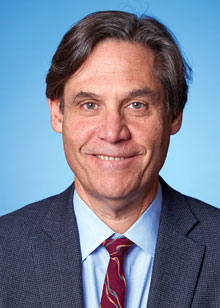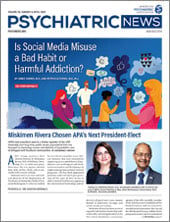Two adolescents presented at the hospital after making a suicide attempt. Although both were 12-year-old girls, that’s where the similarities end. For one, it was her first attempt, and she was from an intact family who was engaged in her treatment. She was living in a single family home in a safe neighborhood. She had no comorbidities, and her family members were healthy.
The other girl’s case was nearly the opposite: It was her fourth suicide attempt that year, and she had alcohol use disorder. She also had asthma, requiring the use of an inhaler. She was being raised by a single parent with mental illness and substance use disorder and had unstable housing, staying with various relatives in crime-ridden neighborhoods for several months.
Yet both girls were deemed to have the same level of need and were granted the same length of hospital stay by their insurance provider, said Joe Parks, M.D., medical director of the National Council for Mental Wellbeing, distinguished research professor of science at Missouri Institute of Mental Health at the University of Missouri, and an outpatient psychiatrist at Family Health Center.
“What’s clear is that the payor’s methodology factored in only the depression and suicidality and their intensity. Needs assessments must look beyond the current symptoms,” said Parks, who told Psychiatric News he discovered many cases like this while investigating complaints of improper denial of inpatient psychiatric care while serving as director of Medicaid in Missouri. “Historically, services have been decided one at a time, but people have multiple illnesses that interact, which affects the intensity and duration of services that they need.”
The National Council is now calling for a nationwide paradigm shift in the way these service intensity assessments are conducted for people experiencing mental illness or substance use, according to a report that the nonprofit co-wrote with the American Association for Community Psychiatry (AACP) and the American Academy of Child and Adolescent Psychiatry (AACAP).
Specifically, the report calls for more widespread adoption of the Level of Care Utilization System family of tools (LOCUS FT), originally developed by AACP in the early 1990s. There are now separate tools for children and adolescents, children 5 years and under, and individuals with substance use disorder (the American Society for Addiction Medicine Patient Placement Criteria, or ASAM Criteria).
The tools guide clinicians to objectively score patients on their risk of harm, functional status, comorbidities, recovery environment, prior treatment/response, and the engagement of both the patient and family. Parks said use of these tools will allow clinicians to recommend more objective, accurate, and equitable treatment plans and transitions in care that factor in a more complete view of patients.
“This report moves us toward a national standard,” said Michael Flaum, M.D., emeritus professor of psychiatry at the University of Iowa Carver College of Medicine and report co-author. “Payors, providers, patients, and the public should have a common language around which to understand how basic behavioral health services are funded.”
“The standard won’t call for specific services such as an SSRI or ECT, but would describe broad categories of service intensity need for a given patient at a given time,” he told Psychiatric News.
California passed
landmark legislation (SB 855) that took effect in 2021, requiring all insurers in the state to use clinical practice guidelines from nonprofit associations, namely LOCUS FT and ASAM Criteria, when making medical necessity determinations around behavioral health. Now, these guidelines must be used by payors when determining service intensity, level of care placement, continued stay, and transfer or discharge.
Oregon and Illinois have followed suit with similar legislation, and the New York State Office of Mental Health has approved similar regulations. “The goal, the North Star, is to get federal legislation passed that requires all payors to use these standards,” Flaum said. “Using LOCUS FT and ASAM Criteria allows the level of services devoted to each patient to be determined by consistent and transparent set of criteria, rather than factors such as where they live, or which insurance they have.”
A
landmark class action ruling in
Wit v. United Behavioral Health (UBH) in February 2019 paved the way for more widespread use of LOCUS FT and ASAM Criteria. That’s when a U.S. district court found that UBH breached its fiduciary duty by refusing coverage for 50,000 people in need of behavioral health care by using its own standards focused on cost containment rather than on a set of “generally accepted standards” of care. The original
Wit decision, which is still being litigated, set forth the following eight generally accepted standards of mental health and substance use care that are spelled out in National Council’s report:
•
Target the underlying condition, not just its symptoms.
•
Treat comorbidities (medical, psychiatric, substance use, and developmental disabilities) in a coordinated way.
•
Provide care in the least intensive and restrictive level that is safe and effective.
•
Choose a higher level of care when there is ambiguity.
•
Include services to maintain functioning as well as to prevent deterioration.
•
Meet individual patient needs on duration of care without predetermined limits.
•
Take into account the unique needs of children and adolescents.
•
Base treatment on a multidimensional assessment that considers a wide variety of information.
Although the Ninth Circuit eventually reversed the original
Wit decision, plaintiffs requested another rehearing, arguing that allowing insurers to use guidelines that deviate from the medical standards would have “an enormous and devastating impact.” In 2022, a
coalition of medical associations, health advocates, and attorneys general from 15 states filed amicus briefs in support of the plaintiffs’ petition for a rehearing. In August 2023, the Ninth Circuit released a
third ruling vacating its earlier findings, leaving the door open for some plaintiff claims to be reprocessed.
Using the principles of the
Wit decision, a separate National Council
report provides clinicians and patients with practical advice, strategies, and templates to overcome prior authorizations or appeal denials of behavioral health care, Parks said.
Gaining more widespread adoption of the LOCUS FT tools may be an uphill battle. Clinicians report being overburdened with EHR and other paperwork responsibilities, and additional training on the tools would be required. Parks sees these tools as taking the place of other, less value-added documentation.
“We’re up against one of the most powerful industries in the world,” Flaum said. “There’s a lot of momentum against this. Right now, every payor and every system can have its own criteria for needs assessment, and who knows who wrote it, how to decipher it, and who’s benefiting from it. ... The use of a common-sense standard approach that can be shared and understood by all stakeholders is long overdue.” ■


